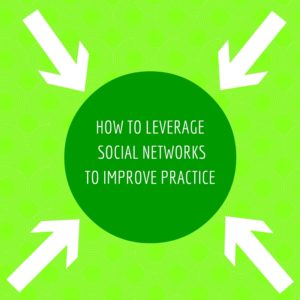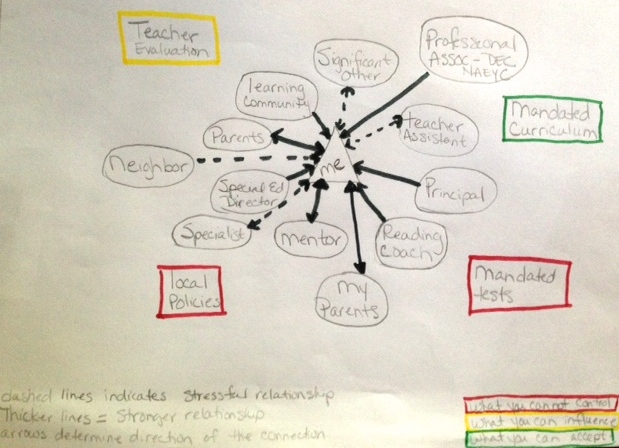 In this series, I’m exploring how #ece professional development is failing teachers.
In this series, I’m exploring how #ece professional development is failing teachers.
In my opinion, our professional development (PD) efforts do not include sufficient attention to supporting teachers’ social-emotional skills, and we need to approach PD from a more wholistic perspective.
In order to support the social-emotional well-being of adult learners, I’ve offered five skills that can be addressed in equal parts during PD, which in the past, has been solely oriented toward compliance, implementation, and change in practice.
The five social-emotional skills include:
When I was working as an early interventionist, I routinely created eco-maps with families to identify their resources, priorities, and concerns. The maps were generated by listing the child’s name (or all members of the family) in the center of a blank piece of paper.
Eco-maps help identify what’s working and what barriers exist.
We would then talk about various relationships the child/family had with others, particularly in terms of social supports or boundary issues created by these relationships. We would also talk about various stressors, strengths and resources, and we would explore opportunities for engagement within their family and the broader community.
As we talked, we would use symbols (e.g., dotted lines, stars), narratives, and other means (e.g., colored pencils) to illustrate the nature of the the transactions between the child/family, others, and the environment.
 The resulting eco-map served as a guide in helping to set priorities, celebrate strengths, and understand events within a context (i.e., with greater situational awareness).
The resulting eco-map served as a guide in helping to set priorities, celebrate strengths, and understand events within a context (i.e., with greater situational awareness).
But how can eco-maps be used in professional development?
This posts explore the use of eco-maps to strengthen the social-emotional health and well-being of adult learners, and continues with the fourth in a series on why professional development is failing teachers and makes the argument that we need to support teachers’ situational awareness.
Situational awareness: ability to see and understand what is happening, why it is happening, and what is likely to happen next; mindful of what is going on in terms of issues, concerns, relationships, and group dynamics; ability to predict and take action regarding future events.
Suggestion for PD:
Just as many of us have done in our work in early intervention, we can use eco-maps with adult learners (preservice and inservice) to help them gain clarity, organize, and better understand the nature of personal and professional interactions.
The human brain works best with information presented not in the form of isolated data but built in patterns of meaningful connections, in a community of data, as it were” (Parker J. Palmer, p. 136, Courage to Teach).
Further, there has been an increasing interest in the concept of communities of practice (CoPs) within the field of education, and how these CoPs can help support (or hinder) the professional development and growth of providers.
Eco-maps can help examine if CoP are supporting professional development efforts.
Of course, CoPs do not occur in a vacuum-they are created and sustained by the strength of personal and professional social networks. As the shown in the diagram, each of us is influenced, whether directly or indirectly, by myriad individuals, systems, and factors.
In education, these influences stem from those most directly related to us such as the children and family with whom we work, colleagues, friends, our own family, local supervisors, and coaches/consultants that support our professional development. Influences also come from those who oversee our work at the organizational level such as directors and principals or professional membership and advocacy organizations. Lastly, the broader system, also, influences our decisions and relationships, including circumstances at the local, state, and federal levels, as well as regional and cultural forces.
Eco-maps are an effective way for educators and even leadership to examine their networks and consider the strengths, weaknesses, and supports available by utilizing such networks.
Directions for Creating an Adult Learner Eco-Map:
- Invite the adult learner (member of a Co-P) to open a blank e-note, WORD document, or grab a blank piece of paper.
In the center, have the adult learner put their name, initials, nickname, or even a picture of themselves. - Have the adult leaner brainstorm people with whom they interact, both professionally and personally, on a daily or at least monthly basis. Each person can be named in a circle or, again, the learner can use initials, nicknames, titles, or pictures.
- Next, have the adult learner consider systems level or external events such as policies, rules, and obligations. Each of these contextual variables can be placed in a square.
- After all people and environmental variables have been identified, the adult learner can code or illustrate the nature of the relationships and impact of the environmental variable on their social-emotional health and well-being. Here are a few coding ideas:
- Use colors to signify variables the learner has control over (i.e., green), what they can influence (i.e., yellow), and what they need to accept, at least for the time being (i.e., red).
- Use arrows to illustrate the direction or flow of the relationship (e.g., top down, bidirectional).
- Use solid lines to indicate strong positive relationships and dotted lines to show where barriers and/or stressors may exist.
- Consider coding relationships and environmental variables using the categories of emotional, physical, or financial.
Eco-maps can help adult learners set priorities, capitalize upon strengths, and gain understanding of contextual influences.
By developing eco-maps, adult learners gain awareness of healthy/strong relationships, as well as challenging relationships. The process, also, aids in helping adult learners to explore how external factors are impacting their decision-making. Lastly, eco-maps can be used to better understand the direction or flow of their resources and energy.
P.S. Continue learning how you can design and deliver PD to strengthen the social-emotional skills of adult learners by reading the next blog post titled, “Can You Hear Me? Two PD Techniques To Improve Interactions and Relationships”
References:
Gatmaitan, M. & Lyons, A. (2013). Ohio’s early intervention community of practice: Coaching manual. Unpublished document. Kent State University.
Harjusola-Webb, S., Gatmaitan, M., & Lyons, A. (2013). Empowering families: The early intervention in natural environments professional development community of practice project in Ohio. Social Welfare: Interdisciplinary Approach, 3(1).